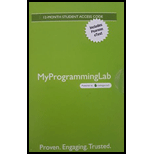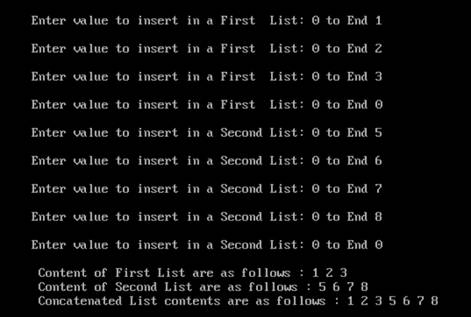
Program plan:
- Item, start variablesare used for input. There is structure listnode having data, nextPtr member variables which represents the linked list node.
- void insert(node **head, int value) function inserts the node in the a linked list.
- node *concat(node *flist, node *slist) function concat the two linked list and return the resultant linked list.
- void printList(node *head) function display the contents of the linked list.
Program description:
The main purpose of the program is to perform the concatenation of two linked list by implanting the concept which is same as strcat() function of string.
Explanation of Solution
Program:
#include <stdio.h>
#include <conio.h>
#include <alloc.h>
#include <ctype.h>
//structure of node of the linked list
typedefstruct listnode
{
int data;
struct listnode *nextPtr;
} node;
//function to insert a node in a linked list
void insert(node &head,int value);
//recursive function to concate the linked list
node *concat(node *flist, node *slist);
//function to print the content of linked list
void printList(node *head);
//main starts here
void main()
{
int item;
node *flist,*slist;
clrscr();
//initialization of start node of linked list
flist =NULL;
slist =NULL;
//loop to getting input from the user for first linked list
while(1)
{
printf("\nEnter value to insert in a First List: 0 to End ");
scanf("%d",&item);
//check condition to terminate while loop
if(item ==0)
break;
//insert value in a linked list
insert(&flist, item);
}
//loop to getting input from the user for second linked list
while(1)
{
printf("\nEnter value to insert in a Second List: 0 to End ");
scanf("%d",&item);
//check condition to terminate while loop
if(item ==0)
break;
//insert value in a linked list
insert(&slist, item);
}
// print the contents of linked list
printf("\n Content of First List are as follows : ");
printList(flist);
// print the contents of linked list
printf("\n Content of Second List are as follows : ");
printList(slist);
//call the function to reverse the linked list
// and store the address of first node
flist = concat(flist, slist);
//print the contents of concated list
printf("\n Concatenated List contents are as follows : ");
printList(flist);
getch();
}
//function definition to insert node in a linked list
void insert(node &head,int value)
{
node *ptr,*tempnode;
//memory allocation for the new node
ptr = malloc(sizeof(node));
//copy the value to the new node
ptr->data = value;
//set node's pointer to NULL
ptr->nextPtr =NULL;
//if the list is empty
if(*head ==NULL)
//make the first node
*head = ptr;
else
{
//copy the address of first node
tempnode =*head;
//traverse the list using loop until it reaches
//to the last node
while(tempnode->nextPtr !=NULL)
tempnode = tempnode->nextPtr;
//make the new node as last node
tempnode->nextPtr = ptr;
}
}
//function defintion to concat the list
node *concat(node *flist, node *slist)
{
node *ptr;
//check if list is empty
if(flist ==NULL|| slist ==NULL)
{
printf("\none of the lists is empty");
//return the node
returnNULL;
}
else
{
//store first node address
ptr = flist;
//traverse list until last node is not encountered
while(ptr->nextPtr !=NULL)
ptr = ptr->nextPtr;
//store the address of first node of second list
ptr->nextPtr = slist;
}
//return new list
return flist;
}
//function definition to display linked list contents
void printList(node *head)
{
node *ptr;
//stores the address of first node
ptr = head;
//traverse the list until it reaches to the NULL
while(ptr !=NULL)
{
//print the content of current node
printf("%d ", ptr->data);
//goto the next node
ptr = ptr->nextPtr;
}
}
Explanation:In the above code, a structure is created which represents the node of the linked list. Two starting nodes are initialized which contains the address of first node of each list. User is asked to enter the values for first linked list and linked list is created using insert() function by passing the starting pointer and value. This process is repeated to create the second linked list. printList() function is used to display the contents of both lists. Both lists are concatenated using the concat() function by passing the both list. In this function first list is traversed up to last node and then last node pointer points to the first node of second list. Starting node address is returned and stored in the pointer. Finally, concatenated list is displayed using printList() function.
Sample output:

Want to see more full solutions like this?
Chapter 12 Solutions
MYPROGRAMMINGLAB WITH PEARSON ETEXT
- Show the correct stereochemistry when needed!! mechanism: mechanism: Show the correct stereochemistry when needed!! Br NaOPh diethyl ether substitutionarrow_forwardIn javaarrow_forwardKeanPerson #keanld:int #keanEmail:String #firstName:String #lastName: String KeanAlumni -yearOfGraduation: int - employmentStatus: String + KeanPerson() + KeanPerson(keanld: int, keanEmail: String, firstName: String, lastName: String) + getKeanld(): int + getKeanEmail(): String +getFirstName(): String + getLastName(): String + setFirstName(firstName: String): void + setLastName(lastName: String): void +toString(): String +getParkingRate(): double + KeanAlumni() + KeanAlumni(keanld: int, keanEmail: String, firstName: String, lastName: String, yearOfGraduation: int, employmentStatus: String) +getYearOfGraduation(): int + setYearOfGraduation(yearOfGraduation: int): void +toString(): String +getParkingRate(): double In this question, write Java code to Create and Test the superclass: Abstract KeanPerson and a subclass of the KeanPerson: KeanAlumni. Task 1: Implement Abstract Class KeanPerson using UML (10 points) • Four data fields • Two constructors (1 default and 1 constructor with all…arrow_forward
- Plz correct answer by best experts...??arrow_forwardQ3) using the following image matrix a- b- 12345 6 7 8 9 10 11 12 13 14 15 1617181920 21 22 23 24 25 Using direct chaotic one dimension method to convert the plain text to stego text (hello ahmed)? Using direct chaotic two-dimension method to convert the plain text to stego text?arrow_forward: The Multithreaded Cook In this lab, we'll practice multithreading. Using Semaphores for synchronization, implement a multithreaded cook that performs the following recipe, with each task being contained in a single Thread: 1. Task 1: Cut onions. a. Waits for none. b. Signals Task 4 2. Task 2: Mince meat. a. Waits for none b. Signals Task 4 3. Task 3: Slice aubergines. a. Waits for none b. Signals Task 6 4. Task 4: Make sauce. a. Waits for Task 1, and 2 b. Signals Task 6 5. Task 5: Finished Bechamel. a. Waits for none b. Signals Task 7 6. Task 6: Layout the layers. a. Waits for Task 3, and 4 b. Signals Task 7 7. Task 7: Put Bechamel and Cheese. a. Waits for Task 5, and 6 b. Signals Task 9 8. Task 8: Turn on oven. a. Waits for none b. Signals Task 9 9. Task 9: Cook. a. Waits for Task 7, and 8 b. Signals none At the start of each task (once all Semaphores have been acquired), print out a string of the task you are starting, sleep for 2-11 seconds, then print out a string saying that you…arrow_forward
- Programming Problems 9.28 Assume that a system has a 32-bit virtual address with a 4-KB page size. Write a C program that is passed a virtual address (in decimal) on the command line and have it output the page number and offset for the given address. As an example, your program would run as follows: ./addresses 19986 Your program would output: The address 19986 contains: page number = 4 offset = 3602 Writing this program will require using the appropriate data type to store 32 bits. We encourage you to use unsigned data types as well. Programming Projects Contiguous Memory Allocation In Section 9.2, we presented different algorithms for contiguous memory allo- cation. This project will involve managing a contiguous region of memory of size MAX where addresses may range from 0 ... MAX - 1. Your program must respond to four different requests: 1. Request for a contiguous block of memory 2. Release of a contiguous block of memory 3. Compact unused holes of memory into one single block 4.…arrow_forwardusing r languagearrow_forwardProgramming Problems 9.28 Assume that a system has a 32-bit virtual address with a 4-KB page size. Write a C program that is passed a virtual address (in decimal) on the command line and have it output the page number and offset for the given address. As an example, your program would run as follows: ./addresses 19986 Your program would output: The address 19986 contains: page number = 4 offset = 3602 Writing this program will require using the appropriate data type to store 32 bits. We encourage you to use unsigned data types as well. Programming Projects Contiguous Memory Allocation In Section 9.2, we presented different algorithms for contiguous memory allo- cation. This project will involve managing a contiguous region of memory of size MAX where addresses may range from 0 ... MAX - 1. Your program must respond to four different requests: 1. Request for a contiguous block of memory 2. Release of a contiguous block of memory 3. Compact unused holes of memory into one single block 4.…arrow_forward
- using r languagearrow_forwardWrite a function to compute a Monte Carlo estimate of the Beta(3, 3) cdf, and use the function to estimate F(x) for x = 0.1,0.2,...,0.9. Compare the estimates with the values returned by the pbeta function in R.arrow_forwardWrite a function to compute a Monte Carlo estimate of the Gamma(r = 3, λ = 2) cdf, and use the function to estimate F(x) for x = 0.2, 0.4, . . . , 2.0. Compare the estimates with the values returned by the pgamma function in R.arrow_forward
 C++ for Engineers and ScientistsComputer ScienceISBN:9781133187844Author:Bronson, Gary J.Publisher:Course Technology Ptr
C++ for Engineers and ScientistsComputer ScienceISBN:9781133187844Author:Bronson, Gary J.Publisher:Course Technology Ptr C++ Programming: From Problem Analysis to Program...Computer ScienceISBN:9781337102087Author:D. S. MalikPublisher:Cengage Learning
C++ Programming: From Problem Analysis to Program...Computer ScienceISBN:9781337102087Author:D. S. MalikPublisher:Cengage Learning Systems ArchitectureComputer ScienceISBN:9781305080195Author:Stephen D. BurdPublisher:Cengage Learning
Systems ArchitectureComputer ScienceISBN:9781305080195Author:Stephen D. BurdPublisher:Cengage Learning- Programming Logic & Design ComprehensiveComputer ScienceISBN:9781337669405Author:FARRELLPublisher:Cengage
 New Perspectives on HTML5, CSS3, and JavaScriptComputer ScienceISBN:9781305503922Author:Patrick M. CareyPublisher:Cengage Learning
New Perspectives on HTML5, CSS3, and JavaScriptComputer ScienceISBN:9781305503922Author:Patrick M. CareyPublisher:Cengage Learning




